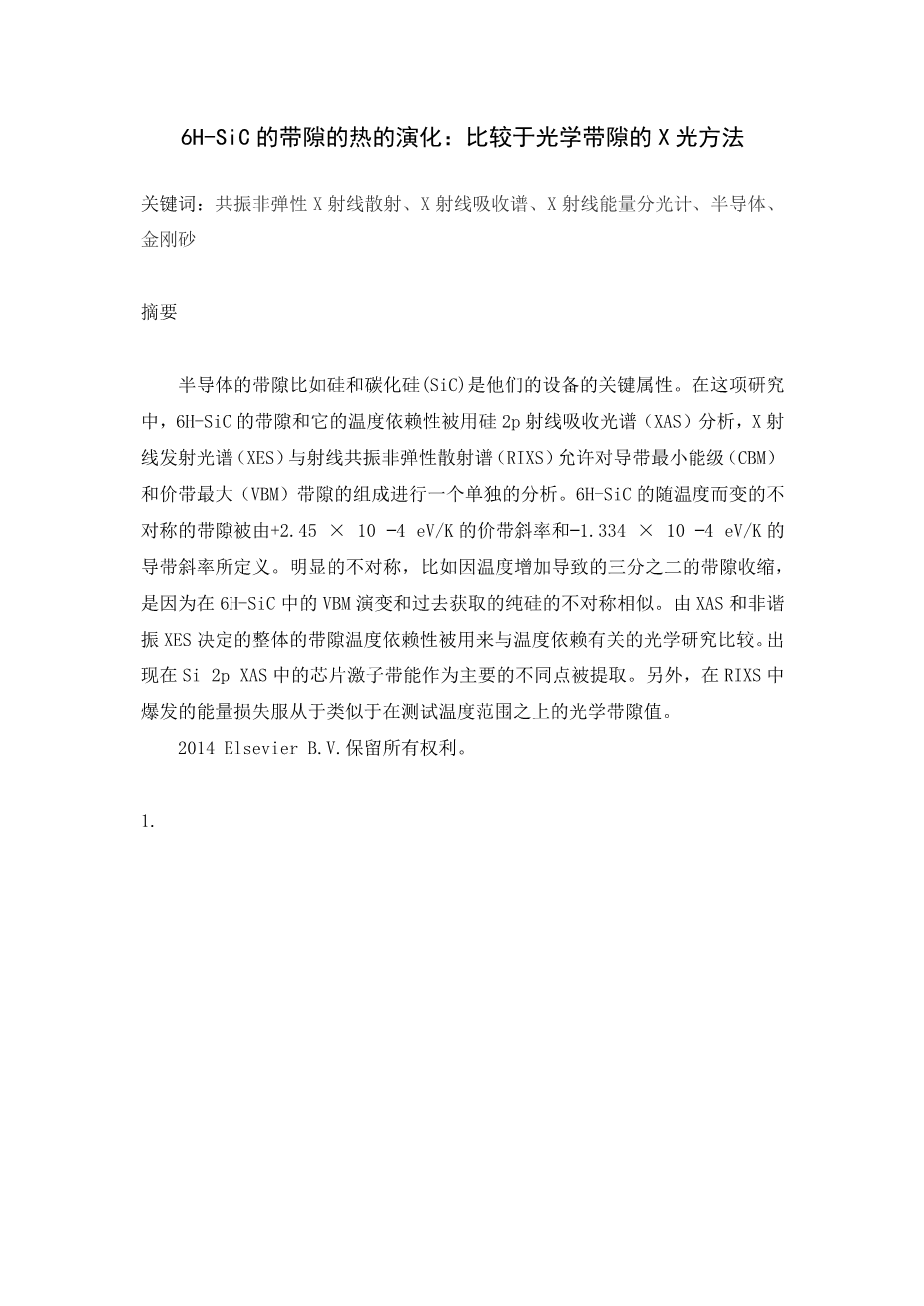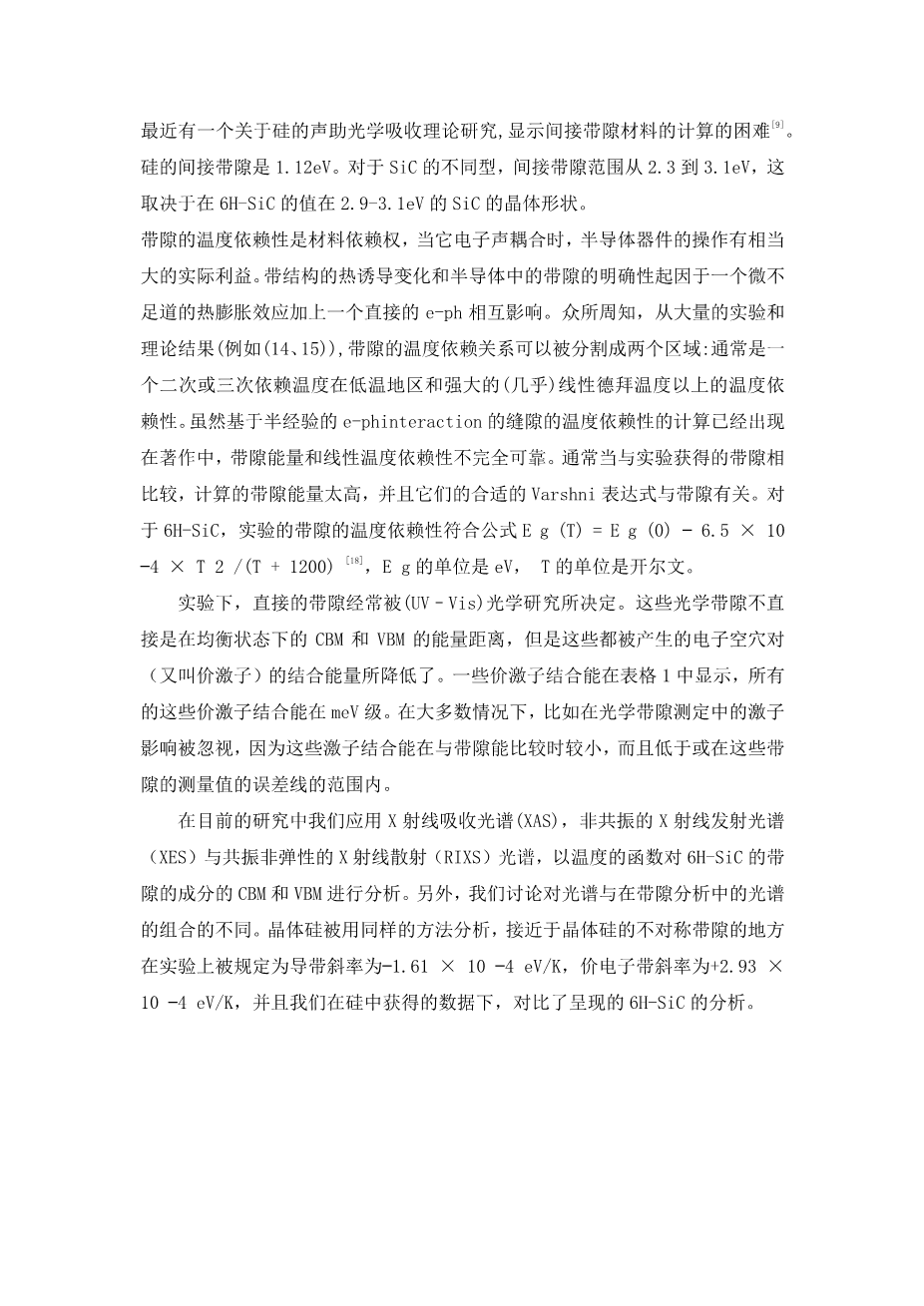Thermal evolution of the band edges of 6H-SiC: X-ray methods compared to the optical band gap
Keywords: RIXS XAS XES Semiconductors Silicon carbide
Abstruct
The band gap of semiconductors like silicon and silicon carbide (SiC) is the key for their device properties. In this research, the band gap of 6H-SiC and its temperature dependence were analyzed with silicon 2p X-ray absorption spectroscopy (XAS), X-ray emission spectroscopy (XES) and resonant inelastic X-ray scattering (RIXS) allowing for a separate analysis of the conduction-band minimum (CBM) and valence-band maximum (VBM) components of the band gap. The temperature-dependent asymmetric band gap shrinking of 6H-SiC was determined with a valence-band slope of 2.45 × 10 −4 eV/K and a conduction-band slope of −1.334 × 10 −4 eV/K. The apparent asymmetry, e.g., that two thirds of the band-gap shrinking with increasing temperature is due to the VBM evolution in 6H-SiC, is similar to the asymmetry obtained for pure silicon before. The overall band gap temperature-dependence determined with XAS and non-resonant XES is compared to temperature-dependent optical studies. The core-excitonic binding energy appearing in the Si 2p XAS is extracted as the main difference. In addition, the energy loss of the onset of the first band in RIXS yields to values similar to the optical band gap over the tested temperature range.
© 2014 Elsevier B.V. All rights reserved
- Introduction
Semiconductor materials are the heart of solid state electronics with devices including transistors, switches, diodes, photovoltaic cells and detectors [1]. Silicon is the workhorse for information technologies and photovoltaic photon harvesting, while SiC is a promising material for high power, high temperature and high frequency applications, because of its extreme thermal and chemical stability together with the large electron saturation velocity and mobility [3,4] and SiC has applications in light-emitting diodes [2–4], temperature sensors [5] and as neutron detectors [6,7]. The most stable of about 100 different SiC polytypes, the hexagonal 6H-SiC containing six SiC pairs per unit cell with the stacking sequence ABCACB [8] is the subject of this study.
The physical characteristics of a semiconductor are governed by the electronic band structure and the band gap is the key property. This band gap is defined as the difference in the energy between the lowest point of the conduction band (conduction band minimum, CBM) and the highest point in the valence band (valence band maximum, VBM). Silicon and SiC both have an indirect band gap meaning that the VBM and CBM are separated in k-space. Recently there was a theoretical study about the phonon-assisted optical absorption in silicon, which showed the difficulties in calculations of indirect band gap materials [9]. The indirect band gap is 1.12 eV for silicon. For different polytypes of SiC the indirect band gap ranges from 2.3 to 3.1 eV depending on the crystal structure of SiC [10] with a value of about 2.9–3.1 eV for 6H-SiC [11].
The temperature-dependence of the band gap is a material-specific property, which is of considerable practical interest for the operation of semiconductor devices while it is physically driven by the electron-phonon (e-ph) coupling [12]. Thermally induced changes of the band structure and explicitly in the band gap of semiconductors arise from a trivial thermal expansion effect plus a direct e-ph interaction effect [13]. It is known from a wealth of experimental and theoretical results (for example [14,15]) that band gap temperature dependencies can be split in two regions: usually a quadratic or cubic dependence on temperature in the cryogenic region and a strong (nearly) linear temperature dependence above the Debye temperature. Although calculations of the temperature-dependence of the gaps based on semi-empirical e-phinteraction have appeared in the literature, the band gap energies and the linear temperature dependence are not completely reliable. Typically the calculated band-gap energies are too high [16] when compared to experimentally obtained band gaps and their fitted Varshni expressions [17] of temperature relations for band gaps. For 6H-SiC, the experimental temperature dependence of the band gap is fitted with E g (T) = E g (0) − 6.5 × 10 −4 × T 2 /(T 1200) [18] with E g in eV and T in Kelvin.
Experimentally, the direct band gaps are often determined with (UV–Vis) optical studies. These optical band gaps are not directly the energetic distance of the CBM and VBM under equilibrium conditions, but these are lowered by the binding energy of the created electron-hole pair, the valence exciton [1]. Some valence exciton binding energies are shown in Table 1 and all these valence exciton binding energies are in the meV regime. In most cases such excitonic effects are neglected in the optical band gap determination, because these excitonic binding energies are small in comparison to the band gap energy and are below or in the range of the error bars of the measurements of these band gaps.
In the present study we apply X-ray absorption spectroscopy (XAS), non-resonant X-ray emission spectroscopy (XES) and resonant inelastic X-ray scattering (RIXS) spectroscopy for analysis of the CBM and VBM components of the band gap of 6H-SiC as a function of temperature. In addition we discuss the difference between this combination of spectroscopies and optical spectroscopies in the band-gap analysis. Crystalline silicon was analyzed in a similar study, where an asymmetric band gap closing of crystalline silicon was experimentally determined with the slope of −1.61 × 10 −4 eV/K for the conduction-band and 2.93 × 10 −4 eV/K for the valence-band [20] and w
剩余内容已隐藏,支付完成后下载完整资料


英语译文共 16 页,剩余内容已隐藏,支付完成后下载完整资料
资料编号:[485640],资料为PDF文档或Word文档,PDF文档可免费转换为Word


